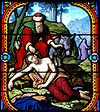- Parable of Drawing in the Net
-
 Jan Luyken etching of the parable, Bowyer Bible.
Jan Luyken etching of the parable, Bowyer Bible.
The Parable of Drawing in the Net is a parable of Jesus which appears in only one of the Canonical gospels of the New Testament. According to Gospel of Matthew 13:47–52 it refers to the final judgment.[1] This parable is the seventh and last in Matthew, which began with the parable of the Sower.[2]
An abbreviated version of the parable also appears in the non canonical Gospel of Thomas (Saying 8).[3]
Contents
Narrative
The parable is as follows:
"Again, the Kingdom of Heaven is like a dragnet, that was cast into the sea, and gathered some fish of every kind, which, when it was filled, they drew up on the beach. They sat down, and gathered the good into containers, but the bad they threw away. So will it be in the end of the world. The angels will come forth, and separate the wicked from among the righteous, and will cast them into the furnace of fire. There will be the weeping and the gnashing of teeth."
Jesus said to them, "Have you understood all these things?"
They answered him, "Yes, Lord."
He said to them, "Therefore every scribe who has been made a disciple in the Kingdom of Heaven is like a man who is a householder, who brings out of his treasure new and old things."
— Matthew 13:47–52, World English Bible
Interpretation
Like the parable of the Tares, earlier in Matthew 13, this parable refers to the final judgment.[1] Here, the imagery is drawn from the separation of edible from inedible fish caught by a net, probably a seine net.[2][4] The passage says that "the angels will come and separate the wicked from the righteous" in a similar way.
John Chrysostom described this as an "terrible parable,"[5] noting that:
And wherein does this differ from the parable of the tares? For there too the one are saved, the other perish; but there, for choosing of wicked doctrines; and those before this again, for not giving heed to His sayings, but these for wickedness of life; who are the most wretched of all, having attained to His knowledge, and being caught, but not even so capable of being saved.[6]
Jesus final comments indicate that "true teachers of the kingdom display the kingdom's treasure for all to see."[4]
See also
- Ministry of Jesus
- Five Discourses of Matthew
References
- ^ a b R. T. France, The Gospel According to Matthew: An introduction and commentary, Eerdmans, 1985, ISBN 0802800637, p. 230.
- ^ a b Catholic Encyclopedia: Parables.
- ^ Gospel of Thomas: Lamb translation and Patterson/Meyer translation.
- ^ a b Craig S. Keener, A Commentary on the Gospel of Matthew, Eerdmans, 1999, ISBN 0802838219, pp. 392-394.
- ^ Patrick J. O'Reilly, Light Divine in Parable and Allegory, Kessinger Publishing, 2003 (originally 1930), ISBN 0766131351, p. 116.
- ^ John Chrysostom, Homily 47 on Matthew.
Parables of Jesus Canonical / New Testament Barren Fig Tree • Budding Fig Tree • Counting the cost • Drawing in the Net • Faithful Servant • Friend at Night • Good Samaritan • Great Banquet • Growing Seed • Hidden Treasure • Lamp • Leaven • Lost Coin • Lost Sheep • Master and Servant • Minas • Mustard Seed • New Wine into Old Wineskins • Pearl • Pharisee and the Publican • Prodigal Son • Rich Fool • Rich man and Lazarus • Sower • Strong Man • Talents • Tares • Ten Virgins • Tree and its Fruits • Two Debtors • Two Sons • Unjust Judge • Unjust Steward • Unforgiving Servant • Wicked Husbandmen • Wise and Foolish Builders • Workers in the Vineyard
Non-Canonical / Disputed Christianity Portal Categories:
Wikimedia Foundation. 2010.
